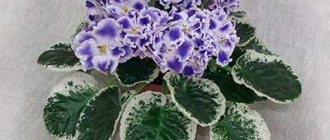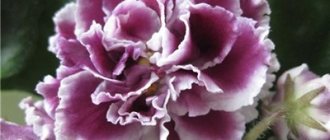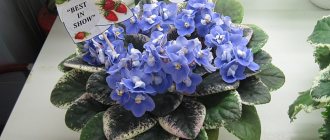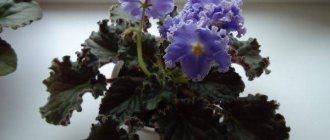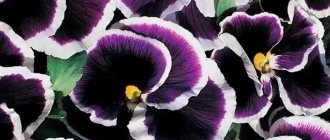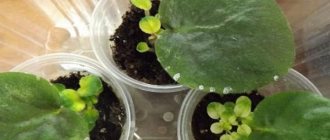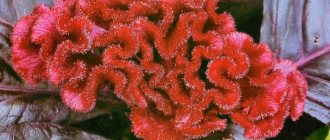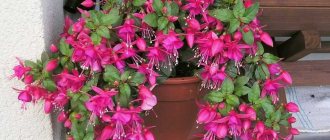Saintpaulia Summer Twilight recently celebrated its 10th anniversary. The variety was bred in 2007. The creator is Konstantin Lvovich Morev, a student of the most outstanding breeder in Russia, Boris Mikhailovich Makuni.
Moreva varieties are distinguished by their originality and are not inferior in quality to foreign ones, often superior to them. Summer twilight has already entered the golden fund of the best violets of domestic selection.
Description of the Moreva variety
Violet class – compact standard. The socket is neat, for display.
Leaves
The foliage is rich green, medium in tone, closer to dark. There is a white border along the edge. The shape is harmoniously oval, the surface is quilted.
Flowers
The flowers are semi-double stars, have 7-12 wide, slightly pointed petals, arranged in light waves. There is a small corrugation along the edge. The shape of the flower is voluminous and lush. Flower diameter - 5-6 cm. Color: lilac-violet, with a white thin irregular border and eye. The color of the edge smoothly, but without prolonged stretching, flows into a rich, cold violet tone, giving the flower a watercolor appearance.
The buds are collected in brushes of 3-5 pieces. on each peduncle. They are strong, stocky, not long, bend slightly under the weight of the flowers, which easily form a neat hat in any growing conditions. Flowering is persistent, abundant, lasts up to 3 months.
Advantages
The Summer Twilight violet has a lot of advantages, thanks to which it has gained not only collectible fame, but has also become a sought-after variety for indoor decoration:
- A characteristic decorative appearance that evokes associations with the night sea, thunderclouds, and evening twilight. A beautiful elegant combination of variegated foliage and white and purple flowers.
- Exhibition quality. Compact, not “sprawling” rosette, stable peduncles, abundant flowers.
- No special requirements. This is a good variety that will show itself with standard care for violets. Does not require special measures, stable and reliable.
The violet will show its potential only after 2-3 blooms. The first flowers may be small and simple.
Characteristics of species with photos
Tired Sun
Variety 2005. The rosette is large, with long petioles, and quite neat. The leaf is dark green, quilted. The flowers are large (up to 6 cm), from simple, in the first flowering, to heavily double.
The color of violet petals is salmon pink, with a darker spot in the center. The spot appears on the seventh day after the bud opens and gradually begins to grow. Depending on the conditions of detention, the central spot can completely fill the petals, but usually its spread ends 4-5 millimeters from the edge of the petal, creating the effect of a wide border.
Attention: The variety feels great without additional lighting. When propagating, children from the leaf produce quickly, actively grow and gain green mass. Blooms seven months after planting
It blooms seven months after planting.
Stone Flower
Variety 2007. Standard socket. The leaves are large and wavy (some breeders write about severe leaf curling that occurs with excess light). The foliage is rich green.
The flowers are medium (up to 4 cm), semi-double and double. The color of the petals is ruby-violet, with darker tips, a white border and a greenish fringe. The violet bud blooms lighter, more monochromatic and darkens throughout the entire flowering period, the corner areas of the petals much faster.
By the end of flowering, some parts of the flower are almost black. The color of the fringe also becomes more saturated towards the end of flowering and stands out strongly against the background of the petals. The structure of the petals is dense, which allows them to better tolerate changes in air humidity. The bud opens completely in 3 weeks.
It produces flower stalks not at once, but gradually, so it is unlikely to get an abundant head of flowers.
When propagated by leaves, the violet produces babies reluctantly. It grows and develops very slowly to the size of a large starter. Then it begins to gain leaf mass more actively. An adult plant is unpretentious. It feels great on a windowsill with natural light and tolerates overflow and drought well.
apple blossom
It is not recognized as a variety by the breeder himself, but it has made an impression on many flower growers and is included in their collections.
The rosette is not very neat, but can be trained when the light changes. The petioles of the leaves are a little long. The foliage is lush green, edged with white.
The flowers are simple and semi-double, located on slender peduncles that cope well with a large number of buds. The color of the petals is soft pink. The flowering of Saintpaulia is very abundant and frequent, it blooms with a cap.
Does not like excessive lighting. Feels good on eastern window sills. When growing on a shelf, it is better to place it on the edge of the shelf.
Olesya
Seedling. The socket is neat and compact. The foliage is medium green and quilted. The flowers are quite large (up to 5 cm), very lush and elegant. The shape resembles a hemisphere. The color of the petals is unusual - bright neon pink with a darker eye and cherry speckled edges.
The plant produces a large number of flower stalks, each with 4-5 buds. Therefore, it blooms with an amazingly beautiful and lush head. Flowering is long lasting, can last more than 2 months. Sometimes you have to remove the flower stalks so that the rosette has time to gain green mass.
“Olesya”, when propagated by leaves, quickly produces babies. After transplantation, it grows and develops well, gaining green mass. An adult rosette is unpretentious and easily tolerates changes in light, temperature and humidity.
We recommend watching a video about K. Morev’s violet variety “Olesya”:
Growing conditions
The variety is not demanding. No special conditions are needed. Grows well in ordinary apartments.
Conditions of detention:
| Parameter | Conditions |
| Location | Western and eastern windows |
| Lighting | Abundant diffused light without direct sunlight |
| Temperature | +16…+18 °С |
| Humidity | 80 % |
| Priming | Loose, with excellent hygroscopicity. Ready-made or homemade, from peat (2 parts) and perlite (1 part) |
| Pot | Plastic, 1/3 higher in height than in width, compact, diameter - no more than 1/3 of a socket. |
Why should you choose plastic utensils? It is easy to clean, when transplanting, it is easily separated from the walls of the earthen clod, is not exposed to temperatures, and provides good protection against hypothermia or overheating of the roots by the sun’s rays,
Reviews
Elena. “The variety is very elegant and beautiful, a favorite in my collection. This is not the first year I have been growing it. Peduncles are not long. It grows well both on a shelf and in a window. It doesn’t lift its arms up; on the contrary, it can hug the pot because of the heat, but this doesn’t spoil its appearance at all. I’ve been putting it on the window for a year now, and it’s blooming all the time. It’s just finished blooming, I see it’s growing buds again.”
Alina. “But mine is 40 cm and I don’t know whether to leave or give a horse like that. I planted it in partial shade, on a windowsill where direct sunlight does not reach.”
Flower growers really like the Summer Twilight violet.
Violet propagation
Saintpaulia is easily propagated by leaf cuttings and flower stalks. The second method is for professionals and is usually used only by breeders to consolidate the characteristics of a particular bud. At home, propagation by leaf cuttings is preferable.
Rules for choosing cuttings:
- You should choose a leaf from the middle row, not too old and not too young.
- It must be healthy, strong, elastic, without damage.
- You should definitely evaluate the quality of the buds above the leaf; future young plants will receive these signs. Flowers must fully confirm the official description: large, with a clearly visible white border and eye, abundant, double.
You should avoid taking cuttings from flowers with too thin a border and a dark shade - there is a risk of getting spores with pure purple flowers without white color (specimens with genetically absent characteristics).
Further actions:
- The cutting is cut obliquely, the cut is dipped in crushed activated carbon, the cutting is immediately placed in clean water without drying it out.
- The cut should be periodically inspected for the appearance of rot. If it appears, the affected area is cut off again, and the cuttings are placed in fresh water. In the future, it is changed daily.
- After 1-1.5 weeks, roots will appear.
- As soon as the roots reach 1 cm, the cuttings are planted in standard soil for violets.
- In a month, young plants will appear from under the ground.
- They are carefully planted in small pots or plastic cups.
- The mother leaf can be re-rooted.
If the cutting is too large, the process of the appearance of babies may be delayed. To stimulate their growth, the upper half of the leaf blade is cut off.
How Saintpaulia propagates Summer twilight
Violet Raisin - description and characteristics of the variety
This variety of Uzambara violets is best propagated by leaf cuttings. You need to cut them off from the second or third row of the outlet. The lower leaves are unsuitable for reproduction; they do not have enough vital potential for this.
The cut must be made obliquely to increase the rooting area of the cutting. After this, they are planted in the soil. Young rosettes appear after 3-4 months. When the seedlings become stronger, they must be separated from the cuttings.
Violet care
Variegated violets are somewhat more demanding than ordinary ones, although the Summer Twilight variety is highly reliable - it will work even with standard care. However, it is worth considering its features.
- It is advisable to keep it cool, at a temperature slightly below normal room temperature: the white border and shade of the flowers will be more expressive.
- More careful attention to lighting will be required. If the leaves become too green, the plant is not getting enough light.
- If you need a year-round flowering plant, lighting up to 12 hours of daylight is desirable.
- Violets do not like spraying, but need fairly high humidity. This is achieved by placing plants on a tray with wet pebbles, spraying the air nearby or installing ultrasonic humidifiers.
- The shaggy leaves of Saintpaulia actively collect dust, so the room where the plant stands must be impeccably clean. An occasional shower is acceptable for plants that are not yet flowering, but with caution.
Lighting
The most saturated and variegated colors of flowers can be obtained with some darkening. This variety does not tolerate too bright sunlight - the white edges of flowers and leaves get burned very quickly. A day later, after direct exposure to sunlight, they can “burn out.”
It is best if the lighting is natural and diffused. Experienced gardeners place plants on the north or north-west side in summer, and on the east or west side in winter.
For successful development and lush flowering, the daylight hours for violets must be at least twelve hours. Therefore, in winter, the plant needs additional lighting for at least ten hours.
The fact that the violet lacks lighting can be seen by the pale color of the leaves, too elongated cuttings and crowded flowers. This problem can be corrected quite easily - you need to place the flower pot in a more illuminated place or use a fluorescent lamp for additional lighting.
Mr. Summer Resident warns: mistakes when watering violets
The global mistake is the wrong choice of soil. The root system of violets is very sensitive to excess moisture. And if this moisture is too cold, bacterial rot and viral diseases cannot be avoided. Therefore, good drainage and light, air- and moisture-permeable soil are required.
Mistakes when watering:
- Very cold water. The water temperature should always be 5 degrees higher than the ambient temperature.
- The liquid is taken from the tap and does not settle. Salt deposits on the soil “suffocate” the roots, make it difficult for the plant to feed, and can even lead to complete death. The best water for this is rain or melt water (water is frozen in the freezer, then defrosted).
- Frequent watering. Moisturize Saintpaulias only as needed. You need to touch the soil. If it's dry (but not dry), it's time to water it. The frequency depends on the time of year and room temperature, so there are no universal recommendations. Hand test only.
- Too superficial. Water wets only the top layer. The roots that are located below do not receive moisture, and a zone of increased dampness forms on the surface - increasing the risk of disease in the plant. Watering should be done efficiently, so that the water completely passes through the earthen lump and appears in the pan. Excess moisture is drained.
Breeding history
The creator of the variety, Konstantin Lvovich Morev, was born in Moscow on August 9, 1978. By education he is a programmer. Since childhood, he has been interested in growing plants; he has been breeding Saintpaulia since 1994.
In one of the conversations, the breeder admitted that he had always wanted to change everything he grew for as long as he could remember. And it even worked, only the violets stubbornly refused to produce seeds.
K. Morev is called a student of the outstanding violet grower B. M. Makuni. It turns out they lived in the same building. The senders of the letters constantly confused the numbers of their apartments on the envelopes - this confusion marked the beginning of an interesting, useful acquaintance first with Konstantin’s mother, and then with the Makuni family. Boris Mikhailovich shared his experience, talking about varieties, care rules, and introducing scientific literature on violet pollination. And it went!
Morevsky violets are characterized by a compact, even rosette of leaves and a “cap” type of flowering: there are 3-5 buds on the peduncle (in the photo - “SM-Zephyr”)
K. Morev has few varieties, but they are all harmonious, since the author equally works on both the compactness of the rosette and the beauty of the flowers, bringing each sample to the intended ideal. He tries not to lose sight of not only the metric characteristics (number of buds, size of flowers, leaves and the rosette itself), but also the shape, color elements, and development of the root system. He also works on physiology, ensuring that the flower is not a “brake”. Its beauty and quality are inextricably linked, which is fully reflected in the described variety, which was created in 2007.
Transfer
Children should be replanted as needed, regardless of the time of year. As soon as the dishes become too crowded (the violet leaves are more than 2/3 larger than the diameter of the dishes), the young plant is transplanted into a larger pot than the previous one, 2-3 cm in diameter. The method is transshipment. That is, the plant is placed in a new container without violating the integrity of the earthen coma.
Subsequently, the plants are replanted once a year in the spring. Very old plants, over 5-6 years old, will require a rejuvenation procedure. The rosette is cut off at the root, old leaves are removed, and placed in water. As soon as the roots appear, it is planted in the ground according to the usual pattern.
For abundant flowering, violets need a slightly cramped container. A large pot will cause the plant to direct all its energy into the tops.
Peculiarities
The “Summer Twilight” violet was bred by breeder K. Morev.
The plant has green leaves that form into neat small rosettes. They have a slightly concave shape and an interesting patterned structure. The main distinguishing feature of the plant in the description of the variety is the white border, which extends to the leaf itself and the “teeth”. The flowers look like stars. Their diameter reaches six centimeters. They can be terry or semi-double. The coloring is very beautiful: the center, painted in a blue-violet tint, stands out against a white background. The edges of the petals are wavy, visually reminiscent of velvet. The flowers are voluminous and very fluffy. They grow on thick but short peduncles. Sometimes, under the weight of several flowers, the stems can bend forward. The variety is distinguished by its abundant and long flowering, which is why plant growers love it.
Diseases and pests
Possible pest diseases are described in the table:
| Problem | Cause and symptoms | Corrective measures |
| Root rot | The activity of fungi, activated due to lack of care (excessive watering, hypothermia of roots). It grows poorly and slowly, the leaves are deformed, flaccid, without turgor. | Remove the flower from the pot, carefully examine the roots, remove all damaged parts with a sharp knife, and replant in sterile soil. In severe cases, cut off the rosette at the root and re-root it. |
| Gray rot | Caused by bacteria. The buds and peduncles become covered with gray spots, the flowers do not open and become deformed. | Spraying with Topsin-M. Search for errors in maintenance (wrong soil, incorrect watering, ceramic pot, dampness, cold, plant injury, overheating or hypothermia of roots). |
| Powdery mildew | Caused by certain types of fungi. A white coating appears on the leaves and buds. | Treatment with drugs “Topaz”, “Fundozol”, “Bayleton”, revision of conditions of detention. |
| Insects: scale insects, aphids, thrips, mites, whiteflies | Saintpaulias are rarely affected and are typical for plants kept in extremely poor conditions. | Spraying with insecticides “Bazudin”, “Aktellik”, “Fitoverm”, “Vermitek”. Removal of affected parts. Organizing proper care for the plant. |
To avoid the above problems, it is enough to keep the flower in suitable conditions and follow the standard rules for caring for plants in the house. For all beginners, a shower and preventive treatment with insecticides are required. This will prevent pests from appearing.
Creating comfort for Saintpaulia Summer twilight is not difficult in the conditions of an ordinary apartment. Healthy specimens successfully cope with diseases on their own, delighting with fresh leaves and bright flowers.
Top dressing
Feeding the plant should begin two months after transplantation. Alternating organic and mineral fertilizers will give the best results. Why do you need to do this?
An organic mixture containing a lot of nitrogen stimulates leaf growth and is used during rosette formation.
Mineral fertilizing is used during flowering and bud formation. The presence of phosphorus in them provides violets with a bright color and large size of flowers, while potassium helps strengthen tissues.
Note! Do not use fertilizer with a large amount of nitrogen during flowering. Instead of flowers, the violet will begin to grow green mass.
Bush formation
However, to maintain a certain shape, it is necessary to maintain uniform proportions: the bush must consist of three uniform rows of leaves.
You can also remove the lower leaves and be sure to remove dry and damaged ones. During removal, you should carefully grasp the stem with your fingers and cut it off with scissors.
Violet can harmoniously complement any interior and “revive” it.
If the violet that you grew from a leaf often gets sick and does not bloom, we advise you to read the materials at the links.
